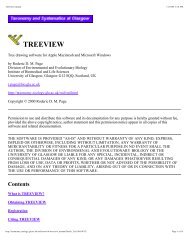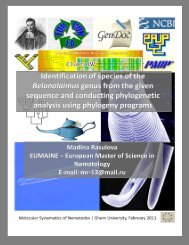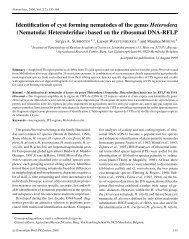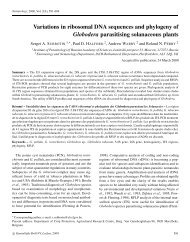Description of Tylenchulus musicola sp. n. (Nematoda ...
Description of Tylenchulus musicola sp. n. (Nematoda ...
Description of Tylenchulus musicola sp. n. (Nematoda ...
Create successful ePaper yourself
Turn your PDF publications into a flip-book with our unique Google optimized e-Paper software.
Z. Tanha Maafi et al.<br />
Fig. 8. PCR with the <strong>Tylenchulus</strong> genus-<strong>sp</strong>ecific primer. Lanes:<br />
M = 100 bp DNA marker (Promega); 1 = <strong>Tylenchulus</strong> <strong>musicola</strong><br />
<strong>sp</strong>. n.; 2 = T. semipenetrans (Ventura, CA, USA); 3 = T. graminis;<br />
4= T. palustris (Cedar Island, FL, USA); 5 = T. palustris<br />
(Perry, FL, USA); 6 = T. furcus; 7= Trophotylenchulus floridensis;8=<br />
control without DNA.<br />
ular analysis <strong>of</strong> our study support the validity <strong>of</strong> Trophotylenchulus<br />
as a separate taxon from <strong>Tylenchulus</strong>.<br />
Separation <strong>of</strong> <strong>Tylenchulus</strong> <strong>sp</strong>ecies has posed a very<br />
challenging task to many nematologists involved with the<br />
identification <strong>of</strong> these nematodes, e<strong>sp</strong>ecially in Florida.<br />
After the description <strong>of</strong> T. semipenetrans, Florida nematologists<br />
encountered <strong>Tylenchulus</strong> J2 that were indistinguishable<br />
from those <strong>of</strong> T. semipenetrans. These J2 were<br />
considered ‘wild races’ <strong>of</strong> T. semipenetrans. Chitwood<br />
was also deceived by the morphological similarity <strong>of</strong> these<br />
wild races with those <strong>of</strong> T. semipenetrans and considered<br />
these ‘wild races’ as native T. semipenetrans populations<br />
(Chitwood & Birchfield, 1957). Only in 1988, and after<br />
the description in South Africa <strong>of</strong> a new <strong>Tylenchulus</strong><br />
<strong>sp</strong>ecies T. furcus, were these wild races <strong>of</strong> T. semipenetrans<br />
separated from T. semipenetrans as two different<br />
<strong>sp</strong>ecies, T. graminis and T. palustris (Inserra et al., 1988a).<br />
The description <strong>of</strong> these two new <strong>sp</strong>ecies facilitated the<br />
separation <strong>of</strong> the three Florida <strong>Tylenchulus</strong> whose J2 can<br />
be identified by the position <strong>of</strong> the rectum, which is visible<br />
in live <strong>sp</strong>ecimens placed in water agar. The results <strong>of</strong><br />
the molecular analysis <strong>of</strong> our study confirm the validity <strong>of</strong><br />
the two <strong>sp</strong>ecies and also provide molecular tools for the<br />
identification <strong>of</strong> these <strong>Tylenchulus</strong>.<br />
Phylogenetic analysis did not reveal any groupings<br />
amongst T. semipenetrans isolates regarding geographical<br />
location or host plant. However, this analysis showed<br />
two groups within T. palustris samples collected from<br />
different hosts. Moreover, the results <strong>of</strong> our preliminary<br />
and unpublished analysis revealed the presence <strong>of</strong> another<br />
undescribed <strong>sp</strong>ecies in Florida, which is morphologically<br />
very similar to T. palustris, but significantly different in<br />
the ITS sequences. This finding is still under study.<br />
Molecular analysis using rRNA genes does not provide<br />
any clear pattern for the evolution and di<strong>sp</strong>ersal <strong>of</strong> <strong>Tylenchulus</strong><br />
<strong>sp</strong>ecies. We can only <strong>sp</strong>eculate that the presence<br />
<strong>of</strong> T. <strong>musicola</strong> <strong>sp</strong>. n. on banana and T. semipenetrans on<br />
citrus might indicate that these <strong>Tylenchulus</strong> <strong>sp</strong>ecies probably<br />
evolved with these plants in their native habitats in<br />
south-east Asia. It was not until later that they were distributed<br />
with infected propagative materials to other countries<br />
and became adapted to parasitise other crops. The<br />
preliminary results <strong>of</strong> the host test suggest that T. <strong>musicola</strong><br />
<strong>sp</strong>. n. is not able to infect sugarcane and citrus, although<br />
these results cannot be considered definitive until<br />
they are confirmed by further tests and extensive field observations.<br />
A modified version <strong>of</strong> the key to <strong>Tylenchulus</strong> <strong>sp</strong>ecies<br />
published by Inserra et al. (1988a) is given here.<br />
Key to <strong>sp</strong>ecies <strong>of</strong> <strong>Tylenchulus</strong> Cobb, 1913<br />
1. J2 and mature female with distinct rectum and anus.<br />
Mature female with body swollen posteriorly for 60%<br />
or more <strong>of</strong> total body length . . . . . . . . . . . . . . . . . . . . . . 2<br />
– J2 and mature female without distinct rectum and anus,<br />
except for T. palustris and T. semipenetrans J2, which<br />
have discernible rectum in live <strong>sp</strong>ecimens. Mature<br />
female with body swollen posteriorly for 58% or less<br />
<strong>of</strong> total body length . . . . . . . . . . . . . . . . . . . . . . . . . . . . . . 3<br />
2. J2withfurcateorbifidtailtip......................<br />
..............T. furcus Van den Berg & Spaull, 1982<br />
– J2 with tail tapering and ending in a bluntly pointed<br />
terminus.........................................<br />
T. graminis Inserra, Vovlas, O’Bannon & Esser, 1988<br />
3. Mature female with short and conoid post-vulval<br />
body section ending in a rounded and smooth terminus.<br />
PVSD = 14.3 (11.2-17.3) μm. Male with stylet<br />
knobs = 1.9 (1.7-2.1) μm wide, basal bulb = 9.1 (8.1-<br />
11.2) μm wide and tail cylindrical, almost truncate<br />
with rounded terminus. Live J2 with discernable rectum;<br />
tail = 50 (44-54) μm long, conoid ending in a<br />
rounded, occasionally indented, terminus. . . . . . . . . . . .<br />
T. palustris Inserra, Vovlas, O’Bannon & Esser, 1988<br />
– Mature female with elongate and conoid post-vulval<br />
body section ending in a rounded terminus. PVSD =<br />
11 (9-14) μm. Male tail cylindrical, thick, ending in<br />
366 Nematology
















